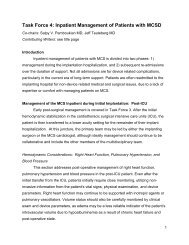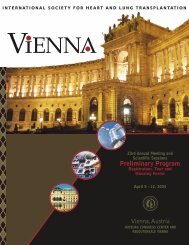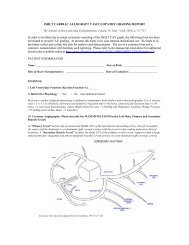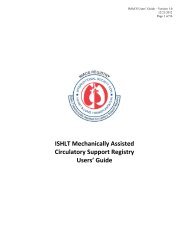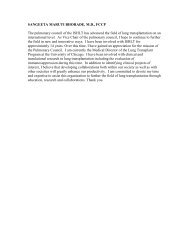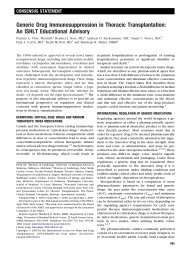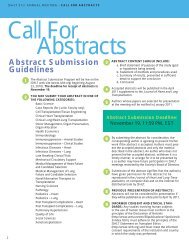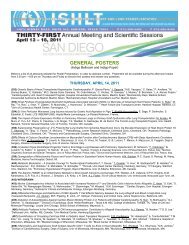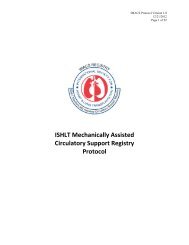Guidelines for the care of heart transplant recipients
Guidelines for the care of heart transplant recipients
Guidelines for the care of heart transplant recipients
Create successful ePaper yourself
Turn your PDF publications into a flip-book with our unique Google optimized e-Paper software.
Costanzo et al.<br />
<strong>Guidelines</strong> <strong>for</strong> Heart Transplant Care<br />
923<br />
Table 5<br />
Match <strong>of</strong> Blood Products to Specific ABO-Incompatible Heart Transplant Scenario<br />
Platelets (managed similarly<br />
Blood group<br />
to plasma)<br />
Recipient’s Donor’s<br />
Red blood cells<br />
(plasma depleted)<br />
Fresh frozen<br />
plasma<br />
Cryoprecipitate<br />
2nd choice<br />
O A O A A A O concentrate<br />
O B O B B B O concentrate<br />
O AB O AB AB, A or B AB A or B concentrate<br />
A B A AB AB, or B a AB B concentrate<br />
A AB A AB AB,AorB a AB A or B concentrate<br />
B A B AB AB, or A a AB A concentrate<br />
B AB B AB AB,AorB a AB A or B concentrate<br />
a Second choice.<br />
Recommendations <strong>for</strong> <strong>the</strong> Selection <strong>of</strong> Candidates <strong>for</strong> ABO<br />
“Incompatible” Heart Transplant: 88,89<br />
Class IIa:<br />
1. The upper limit <strong>of</strong> age or isohemagglutinin titer <strong>for</strong><br />
ABO-incompatible pediatric HT remains unclear.<br />
Level <strong>of</strong> Evidence: C.<br />
2. ABO-incompatible HT can be safely per<strong>for</strong>med in <strong>the</strong><br />
pediatric population in <strong>the</strong> presence <strong>of</strong> positive isohemagglutinin<br />
titers against <strong>the</strong> donor organ.<br />
Level <strong>of</strong> Evidence: C.<br />
3. ABO-incompatible HT, especially in <strong>the</strong> presence <strong>of</strong><br />
donor-specific isohemagglutinins 1:4, should be per<strong>for</strong>med<br />
in an experienced center.<br />
Level <strong>of</strong> Evidence: C.<br />
Recommendation <strong>for</strong> <strong>the</strong> Intraoperative Care <strong>of</strong> ABO “Incompatible”<br />
Heart Transplant Recipients: 88,89<br />
Class IIa:<br />
1. ABO-incompatible HT can be undertaken by per<strong>for</strong>ming<br />
plasma exchange using <strong>the</strong> CPB circuit to remove donor<br />
specific isohemagglutinins.<br />
Level <strong>of</strong> Evidence: C.<br />
2. Plasma exchange using <strong>the</strong> CPB circuit allows <strong>the</strong> safe<br />
<strong>transplant</strong>ation <strong>of</strong> ABO-incompatible organs without <strong>the</strong><br />
need <strong>of</strong> aggressive pre-operative immunosuppressive<br />
<strong>the</strong>rapies or splenectomy.<br />
Level <strong>of</strong> Evidence: C.<br />
Recommendations <strong>for</strong> <strong>the</strong> Monitoring <strong>of</strong> Isohemagglutinin<br />
Levels in ABO “Incompatible” Heart Transplant<br />
Recipients: 88,90<br />
Class IIa:<br />
1. Serial measurements <strong>of</strong> isohemagglutinin titers should<br />
be done in <strong>the</strong> post-operative period. Decisions about<br />
whe<strong>the</strong>r immunosuppressive <strong>the</strong>rapy must be modified<br />
should be based not only on <strong>the</strong> change in isohemagglutinin<br />
titers but also on clinical or pathologic evidence <strong>of</strong><br />
rejection.<br />
Level <strong>of</strong> Evidence: C.<br />
Recommendations <strong>for</strong> <strong>the</strong> Administration <strong>of</strong> Blood Products<br />
in ABO “Incompatible” Heart Transplant Recipients 88–90 :<br />
(See Table 5)<br />
Class IIa:<br />
1. Whole blood products should never be administered to a<br />
child who has received an ABO-incompatible HT, and<br />
<strong>the</strong> families should be educated to communicate this fact<br />
to o<strong>the</strong>r <strong>care</strong>givers in <strong>the</strong> case <strong>of</strong> any future medical<br />
emergency or surgery. Group O red blood cells and<br />
group AB blood elements are safe <strong>for</strong> every blood group<br />
combination.<br />
Level <strong>of</strong> Evidence: C.<br />
2. If red blood cells transfusions are given to any ABOincompatible<br />
HT recipient, red blood cell units should be<br />
matched based on <strong>the</strong> HT recipient’s ABO blood type.<br />
Level <strong>of</strong> Evidence: C.<br />
3. If platelets and/or plasma preparations are needed in<br />
ABO-incompatible HT <strong>recipients</strong>, <strong>the</strong>se blood products<br />
should be matched based on <strong>the</strong> donor’s ABO blood<br />
type.<br />
Level <strong>of</strong> Evidence: C.<br />
Recommendations <strong>for</strong> Immunosuppression in ABO “Incompatible”<br />
Heart Transplant Recipients: 88,89,91<br />
Class IIa:<br />
1. Standard (triple) immunosuppression with a CNI, an<br />
anti-proliferative agent, and CS can be used in children<br />
undergoing ABO-incompatible HT without an increased<br />
risk <strong>of</strong> rejection.<br />
Level <strong>of</strong> Evidence: B.<br />
2. Immunosuppression management beyond <strong>the</strong> peri-operative<br />
period is similar to that <strong>of</strong> <strong>the</strong> ABO-compatible<br />
pediatric HT population.<br />
Level <strong>of</strong> Evidence: B.<br />
Recommendation <strong>for</strong> Rejection Surveillance in ABO “Incompatible”<br />
Heart Transplant Recipients: 88–90<br />
Class IIa:<br />
1. Rejection surveillance in ABO-incompatible HT <strong>recipients</strong><br />
is <strong>the</strong> same as that <strong>of</strong> <strong>the</strong> ABO-compatible HT population.



